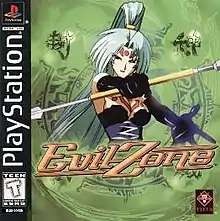Evil Zone
Evil Zone[lower-alpha 2], stylized as EVIL Z♀NE in the PAL region, is a fighting game developed by Yuke's Future Media Creators for the PlayStation in 1999. The player can choose from ten characters to fight in several game modes including story mode, arcade mode, versus mode, practice and survival mode.
| Evil Zone | |
|---|---|
 | |
| Developer(s) | Yuke's Future Media Creators |
| Publisher(s) |
|
| Platform(s) | PlayStation |
| Release | |
| Genre(s) | Fighting |
| Mode(s) | Single-player, multiplayer[lower-alpha 1] |
The storyline of the game tells of a powerful being known as Ihadurca, who can exist in multiple dimensions at one time. Through heavy cost, the inhabitants of the world of I-Praseru (Happy Island) were able to temporarily confine Ihadurca in a dimension known as Evil Zone. Now, a tournament is being held to select the strongest warrior throughout the dimensions to destroy Ihadurca before she can escape from Evil Zone and threaten the world once more.
The story mode is a unique aspect of the game and sets it apart from other fighting games. Each character has a unique story mode which progresses like an ongoing television program, complete with episode names and previews with voice acting. As the mode progresses, you learn more about the character's backstory and why they are fighting, an incentive to play the game with each character. Evil Zone is also one of the few games to feature a fully fleshed out story mode for its boss character.
Gameplay
The game tries to focus on simplicity with a "pick up and play" feel that isn't daunting to new players. Fighting takes place on a 3D field and allows characters to move backwards, forwards, and sidestep left and right with ease. Most of the fighting is done with range-based attacks, but it is possible to attack from a short range and use grapple moves on your opponent. The fighting system only utilizes two main buttons, attack and guard, unlike most fighters, such as the Street Fighter series.
Each character controls in exactly the same manner; however, each character has a set of unique attacks along with an ultra-attack that requires the player to expel Power Stocks. By holding the down the attack button, a character can charge up to 3 Power Stocks. The time that it takes to fully charge a stock depends on the current health of the character; a character with more health will take longer to charge while a character with minimal health could charge all 3 stocks in a few seconds.
Many characters feature attacks that have lengthy animations, which adds a more dramatic and dynamic feel to battles. A general "dramatic" encounter can occur if both characters perform a dash attack at each other at the same time. This results in an event called a Pressure Dash where both characters must rapidly hit buttons in order to gain an advantage over the other player. The most notable animations are those used for each character's ultra-attack, which can last up to 20 seconds long. These animations can become even longer when they are used as the attack that will finish the opponent.
Story modes
Each of the characters story modes is presented like anime television series. Each character gives narration in his or her own cutscenes. Each story mode has its own series title. The animated cutscenes for the game were done by AIC, whose logo can be seen in the background of Danzaiver's stage.
Reception
| Aggregator | Score |
|---|---|
| GameRankings | 62%[2] |
| Publication | Score |
|---|---|
| AllGame | |
| CVG | |
| EGM | 5.25/10[5] |
| Famitsu | 27/40[6] |
| Game Informer | 5/10[7] |
| GameFan | 63%[8] |
| GameSpot | 7.6/10[9] |
| IGN | 4/10[10] |
| OPM (UK) | 6/10[11] |
| OPM (US) |
The game received mixed reviews according to the review aggregation website GameRankings.[2] In Japan, Famitsu gave it a score of 27 out of 40.[6]
Notes
References
- GameSpot staff (July 21, 1999). "PlayStation Evil Zone Ships [date mislabeled as "April 27, 2000"]". GameSpot. CBS Interactive. Archived from the original on January 17, 2000. Retrieved November 12, 2020.
- "Evil Zone for PlayStation". GameRankings. CBS Interactive. Archived from the original on May 1, 2019. Retrieved November 12, 2020.
- House, Matthew. "Evil Zone - Review". AllGame. All Media Network. Archived from the original on November 16, 2014. Retrieved November 12, 2020.
- "Review: Evil Zone". Computer and Video Games. No. 212. Future Publishing. July 1999.
- EGM staff (October 1999). "Evil Zone". Electronic Gaming Monthly. No. 123. Ziff Davis.
- "封神領域エルツヴァーユ [PS]". Famitsu (in Japanese). Enterbrain. Retrieved November 12, 2020.
- Reiner, Andrew (October 1999). "Evil Zone". Game Informer. No. 78. FuncoLand. Archived from the original on June 5, 2000. Retrieved November 12, 2020.
- Ngo, George "Eggo"; Chau, Anthony "Dangohead"; Rodriguez, Tyrone "Cerberus" (September 1999). "Evil Zone". GameFan. Vol. 7 no. 9. Shinno Media. p. 16. Retrieved November 12, 2020.
- Mielke, James (February 11, 1999). "Evil Zone Review [Japan Import] [date mislabeled as "April 28, 2000"]". GameSpot. CBS Interactive. Retrieved November 12, 2020.
- Cleveland, Adam (July 29, 1999). "Evil Zone". IGN. Ziff Davis. Retrieved November 12, 2020.
- Wilton, Pete (July 1999). "Evil Zone". Official UK PlayStation Magazine. No. 47. Future Publishing. p. 90. Retrieved November 12, 2020.
- Maruyama, Wataru (October 1999). "Evil Zone". Official U.S. PlayStation Magazine. Vol. 3 no. 1. Ziff Davis. p. 132. Retrieved November 12, 2020.